Heinz
The business of the H. J. Heinz Company is an example of the possibilities of modern commercial evolution. It is simply the logical result of fitting an idea to public demand and sticking conscientiously to its purpose of fulfilment. All in 57 Varieties.
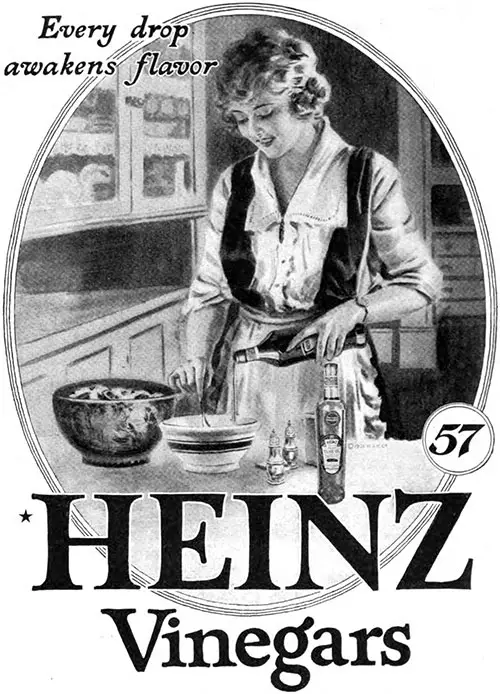
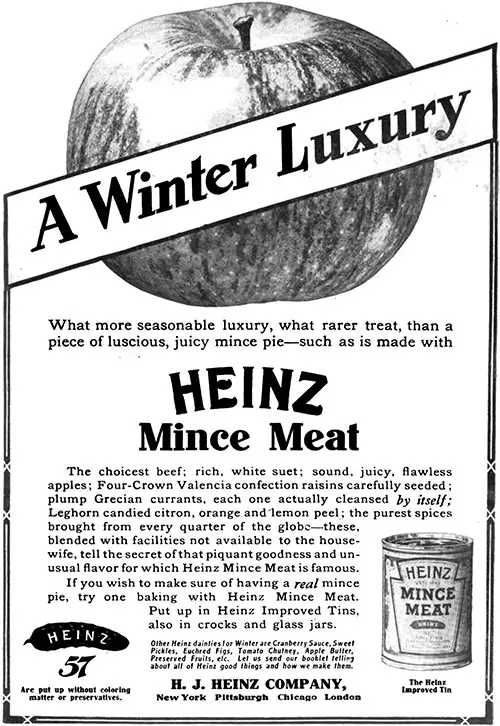
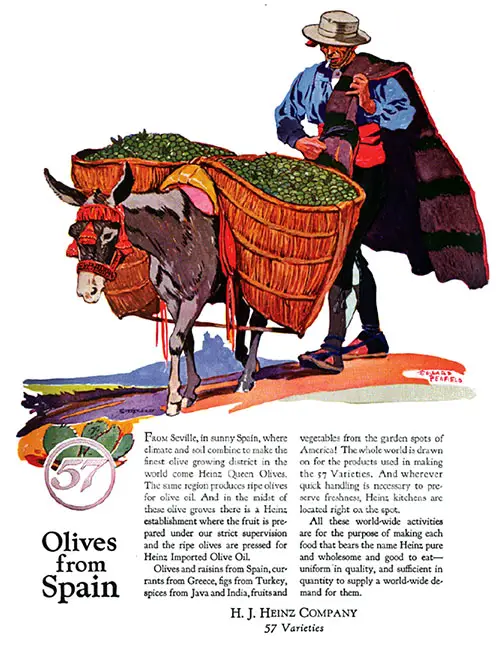
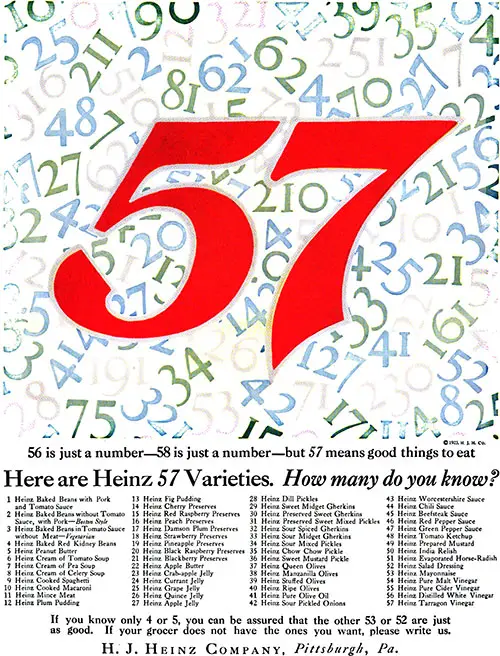
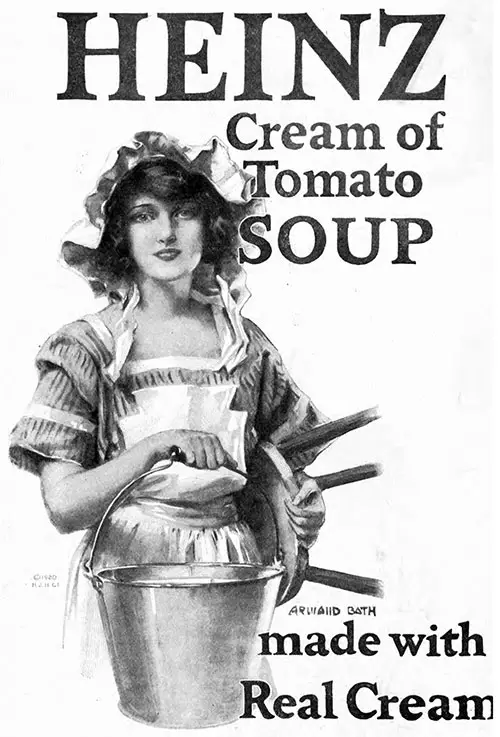
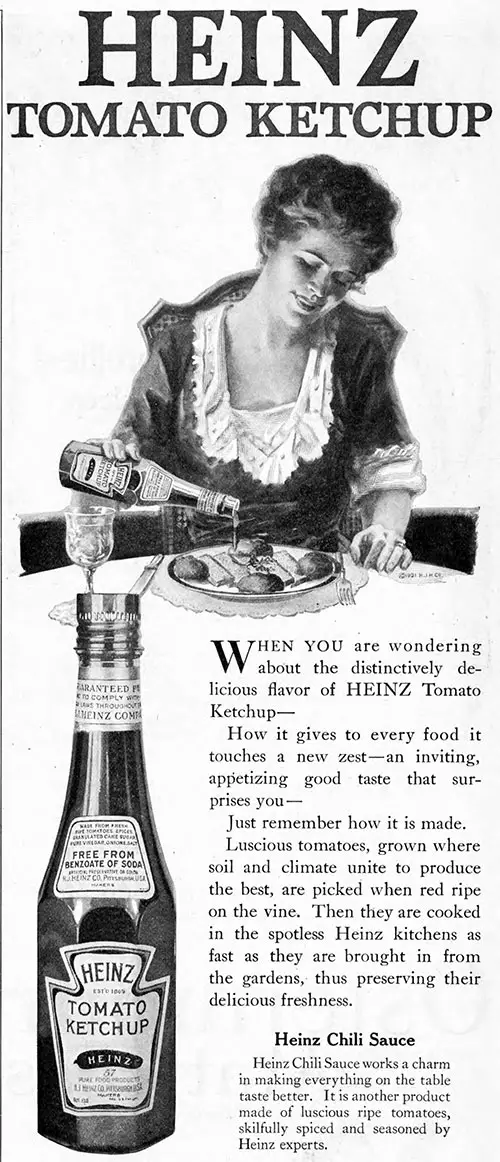
The Story of the “57 Varieties”
The big clock boomed the hour of noon. Where there had been quiet among the diligent workers, there now broke a wave of conversation. The doors were flung open and into the green courtyard passed the hundreds of employees in playful mood.
They made a gladsome picture—these vigorous men and women, with their buoyancy and apparent content with their lot, seeking to make the most of their midday recreation with laughter and healthful exercise.
A visitor to the plant with his host turned to take in the view, and then, above, beheld another sight that compelled interest. At a window, on the second floor of one of the main buildings, stood a man looking upon the scene in the courtyard with a benevolent smile.
He was an elderly man, with a face subtly merging the qualities of power and tenderness. Intently he watched the employees at play. “Whose is the ‘face at the window’?” was asked. “That,” replied the host, “is Mr. H. J. Heinz, the founder of the company.”
During the forenoon, there had been unfolded to the visitor the history of the “House of Heinz”—for that is the scene and subject of this story—and in it the founder of this significant industry stood out an heroic figure.
A truly romantic story it was, blending the elements of sentiment and the dramatic action of big achievements. The deft hand of Arnold Bennett could make of it a romance worthy of the name.
The man who stood at the window controls an industry that has a main plant at Pittsburgh occupying one hundred and sixty city lots and fourteen branch factories in different parts of the United States, with others in Canada, England, and Spain.
He employs over five thousand hands in his factories alone and distributes his products through his own agencies and branch houses in all the principal nations of the world.
Forty-five years ago this same man began preparing and selling food products, but under very different conditions. A small room in a house at Sharpsburg, Pennsylvania, and an adjoining garden of about half an acre were the setting for the first scene of the industrial spectacle of the “House of Heinz.”
Here Mr. Heinz began his business career by raising horseradish, and in the single room he put it up for the local trade. Consider this mighty transition! To the accomplishment of it there must have been brought some force besides the fineness of the products and the integrity of the business management.
Mr. M. S. Achenbach, advertising manager for the H. J. Heinz Company, named the third of the trinity of supports of the Heinz stronghold when he said:
“The success of the Heinz Company has been in no uncertain degree made possible by the character and extent of the company's advertising.” It will be remembered that the vital advertising campaign which early established the “57 Varieties” in the public mind was carried on in the periodicals of national circulation.
The little room and plot of garden at Sharpsburg yielded an inspiration; but this small foundation could not long serve the purposes of a man with the will to build a large structure.
Mr. Heinz expanded his operations to fruits and vegetables. Soon he had established such a lucrative local trade that he decided the scope of Sharpsburg was too limited for his enterprise.
So, in the early seventies, the Heinz plant was moved to Pittsburgh. Here again the words of Mr. Achenbach are pertinent: “The local success after the establishment of the plant in Pittsburgh was great,” he said; “the Heinz products found a ready market and a continuing demand.
But it did not take the young manufacturer long to discover that no matter how superior his product might be, unless he spread the knowledge of that goodness to a wider territory, he should always remain a local manufacturer. So he began to advertise.”
The founder of the “House of Heinz” had an ambition to create a world-wide demand for his products. In those early days, before the efficacy of high-powered advertising had been demonstrated, this was regarded as a dream. But the Heinz dream has reached a dramatic fulfilment.
All this was accomplished by a broadly gauged advertising appeal. The foundation was laid through the weekly and monthly periodicals of national circulation.
Later, the firm used practically every kind of medium that would make for universality of advertising. The response lifted the Heinz Company from a local Pittsburgh concern to an industry of international proportions.
The Heinz Company believed in the persistency of advertising, and this, with the originality of the company's advertising ideas, has had a telling effect. Who is there not familiar with the small green-pickle trade-mark or the sign of the “57 Varieties”?
The green-pickle trade-mark was adopted soon after Mr. Heinz began advertising in the magazines. Later he saw the psychological appeal of a popular catch-phrase.
None that came to his attention seemed just what he wanted until he noticed a sign in a New York shoe dealer’s window. It read: “Twenty styles.” “Why,” thought he, “can I not advertise the number of my products?”
He drew out a memorandum-book and counted the items in the list of foods manufactured by him. There were fifty-seven. “How can I word this?” he mused, “styles’ will not do for a food term; “kinds' does not sound right; fifty-seven, fifty-seven—varieties!”
The thought came to him in a flash. And so the term, “57 Varieties,” was started on its history-making career in the food world. Mr. Achenbach has some interesting things to say about the Heinz advertising ideals. Hear him further: “
The business of the H. J. Heinz Company is an example of the possibilities of modern commercial evolution. It is simply the logical result of fitting an idea to public demand and sticking conscientiously to its purpose of fulfilment.
“Through the national magazines we have commanded a national business. This afterward was supplemented by the results from other media of advertising. The Heinz Company feels that the magazines have been a force in developing a demand for and a confidence in Heinz products.
The ethical standards of the magazines with regard to their advertising are in harmony with our own ideals and have assisted us materially in creating the public confidence that we now enjoy.”
A great industrial success such as that of the H. J. Heinz Company is another vivid illustration of the power of the magazines in working hand-in-hand with an industry in its development.
A product is advertised in a standard magazine; that message from the manufacturer penetrates every section of the country, carrying with it the accepted suggestion that the product advertised must be “right” or it would not be represented in the magazine.
Such is the present-day view of magazine advertising. There is another phase of the mission of the periodical advertisement of equal importance with its ethical and commercial values.
That is its accomplishments in the field of public service. The one instance of the Heinz Company is eloquent of this.
The creating of a demand for Heinz products has set new food standards; has given employment to thousands of people; has made a market for the products of some thirty thousand acres of land; has conserved the food supply and has relieved the housewives of the world of many cares. Many the woman that has blessed Heinz when an unexpected guest arrived!
Arnold Bennett "Romances of Modern Business, Chapter III: The Story of the '57 Varieties'", in The World's Work, 1914, Unpaginated Section.
